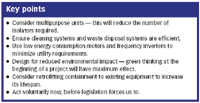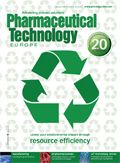Green containment philosophy
Pharmaceutical Technology Europe
Forward-thinking manufacturers are recognizing the need for a more sustainable approach to containment design.
In today's environmentally aware society, companies are expected to operate in an environmentally responsible manner and the pharmaceutical industry is no exception. The environmental impact of pharmaceutical companies is coming under scrutiny. Carbon footprints are usually measured by the amount of greenhouse gases produced, in units of carbon dioxide. Most large pharmaceutical organizations have annual objectives and targets related to reducing their carbon footprint and are typically achieved by inflicting targets on each site to reduce their impact on the environment. These targets to reduce carbon footprints are encouraging equipment suppliers to come up with 'greener solutions'.
Both existing and new facilities are investing heavily in containment solutions to protect operators when handling potent compounds. Isolator technology is now widely accepted as a necessity because new medicines are increasing in potency. However, with some careful forethought it is possible to reduce the environmental impact of the manufacture, operation and maintenance of this type of equipment. There have been many developments in the design and manufacture of containment solutions to lessen their impact on the environment.
Many organizations are now proactively seeking to run their business in an environmentally sustainable manner by subscribing to the ISO 14001 programme. It is not yet the norm for equipment manufacturers to reach this standard, but some do. Many smaller organizations that do not have formal accreditations have environmental policies in place, addressing issues such as car-sharing schemes and switching off computers, lights and heating when not in use. Some innovative equipment manufacturers are adopting green design philosophy to help the pharmaceutical industry to reduce its environmental impact.

Key points
For a site to achieve carbon emissions targets, all elements of that site must be considered. This will include assessing any new equipment for environmental impact. Equipment designs for laboratory and plant containment equipment, such as isolators, have adopted many 'green' elements in recent years. However, there is still a long way to go.
Green containment design
Green containment design philosophy has many facets, including process design, operating procedures, fabrication methods, materials and the design of equipment.
Looking at the actual process that needs containing, and not just supplying a requested item, often produces a more environmentally friendly user requirement specification (URS). By analysing the entire process there are often steps that can be completed in one isolator rather than multiple units. Multipurpose units reduce the negative impact that a pharmaceutical site may have on the environment by reducing the volume of isolators required, which reduces both the fabrication and running requirements.
There are isolators that are designed with flexibility in mind, with lift-up windows to allow laboratory-scale equipment to be placed within. Recent isolator design innovations have enabled complete processes to be housed within a single isolator, reducing both the utility requirement and the actual real estate needed to house the process equipment. For example, if a facility uses a variety of mills in its different processes, it is possible to design a single isolator and have each different mill mounted on an individual skid, which can be interchanged into the isolator when required. This greatly reduces the amount of isolators required reducing both the utilities required for production and the operation of a suite of isolators.
Ensuring cleaning systems are designed to efficiently clean, yet not waste cleaning product or water, is essential. By carefully positioning high-efficiency spray balls within the isolator chambers, less cleaning fluid is required. A triggered wash hose is an additional cleaning aid. This enables the targeted cleaning of dirty areas, rather than using vast amounts of cleaning fluids from the spray balls. This has associated utility and energy consumption savings.
Isolators typically require ancillary equipment, such as fans, filters and extraction systems, which all need to be specified to the optimum size rather than over specified 'just to be safe'. Using low-energy consumption motors and frequency inverters can considerably reduce the utility requirements for running isolators, which reduces the carbon footprint of the site.
Sustainable development
Forward-thinking manufacturers are recognizing the need for a more sustainable approach to containment design. Energy efficiency and environmental impact measurements are not yet mandatory. However, it is only a matter of time before these issues are covered by legislation. Currently, there is a European directive that affects manufactured products, such as electrical and electronic devices or heating equipment: the 2005/32/EC directive on the eco-design of energy-using products (EuPs), provides coherent EU-wide rules for eco-design. Although this does not currently extend to the manufacture of industrial and pharmaceutical equipment, there will be an increased awareness, eventually leading to actions and legislation to promote green design.
Carbon emissions are not the only substances that can harm the environment. Green design involves keeping consumption of other damaging gases to a minimum. Nitrogen is an essential element of isolator design because sealed areas must be purged with nitrogen to reduce the risk of dust explosion. Certain measures, such as using trickle flow rates, can be incorporated into the design of an isolator to ensure nitrogen consumption is kept to a minimum. Ensuring isolator chambers have low leak rates also helps to achieve this.
There is a current trend in the pharmaceutical industry for disposable containment solutions, such as flexible isolator/glove bag technology. These can be convenient from the point of view of cleaning because the flexible isolator is disposed and the time and resources required for cleaning is eliminated. However, the environmental impact of disposing 'single-use' components can be high as the energy required to incinerate is considerable.
There are many elements that affect the carbon footprint of an isolator. A good example would be the operating procedure — the longer a machine is running the greater the carbon emissions. By producing more efficient procedures companies can reduce their impact on the environment.
Isolators will always require resources, which, in turn, will continually impact the environment. It is not possible to eliminate this — minimizing the environmental effect is the target, which can be achieved by a 'design for manufacture' approach. Reduced amount of raw materials coupled with minimum fabrication requirements can lessen the environmental impact considerably in some cases.
The choice of raw materials should be considered in the design process as this can influence the manufacturing process. Isolators are typically fabricated from stainless steel (usually 316 L), but sometimes the materials to be handled within the isolator are chemically aggressive and Alloy 22 would be considered. The decision to make the main fabrication from Alloy 22 must not be made lightly as this metal is naturally a more resistant material and, therefore, requires considerably more manufacturing time and resources.
It is an accepted fact that a lot of pharmaceutical equipment requires consumables. 'Innovative green thinking' should consider which of these consumables are essential. Items; for example, 'O' rings and gaskets are typical replaceable items, but do they have to be? By using a more durable material the lifetime of gaskets may be increased, which reduces the volumes required to be manufactured in the long-term.
Another possibility would be to make more reusable parts, rather than replaceable parts. This may sound like unattainable, yet the bagless vacuum cleaner, which requires no consumables, illustrates that innovation is possible. This approach could be translated to filter design, by washing down a metal filter rather than replacing a filter cloth if the process allows. The process implications must be weighed up when considering such changes in pharmaceutical equipment, however, open thinking and innovative changes can often be applied to equipment to future benefit our environment.
Containment equipment will frequently require utilities such as extraction systems, connection to cleaning fluids and scrubbers systems. Isolators and containment equipment can be supplied with dedicated systems. However, it is often possible to connect into the existing site services for other pieces of process equipment such as filter dryers. Connecting to an existing utility service is a simple and practical way to reduce the impact a pharmaceutical site has on the environment. Using existing facilities has a two-fold benefit on the environment: fewer pieces of equipment need to be manufactured and the energy consumption to run one central system is smaller than running individual systems for each item of equipment.
Retrofitting containment to existing process equipment, rather than purchasing new contained systems, can be an extremely effective way of avoiding unnecessary fabrication and, therefore, reducing environmental impact. Many types of pharmaceutical machinery, such as tablet presses, granulators and mills, can be adapted for containment rather than replacing the entire piece of equipment. For example, if a facility has an existing tablet press, but needs to upgrade to accommodate a new product of higher potency, it is possible that an isolator can be designed to attach to the existing framework to contain the tabletting process. Air flows and pressure regimes must be carefully balanced, but thorough design will provide robust containment with much lesser environmental impact than the purchase of a new contained tablet press.
Isolators are an effective containment measure, but there are other more environmentally friendly containment options available. In certain applications, such as for charging reactors, split butterfly valves can often be used for charging applications in place of complete isolator systems. The fabrication process is much less damaging to the environment and manual valves do not consume energy. Using containment valves instead of downflow booths, which are extremely heavy on energy and utility consumption, is also a good idea. Split butterfly valves save on resources for both running and fabricating isolator or downflow booth systems.
Conclusions
There is much we can do to reduce the environmental impact when designing, manufacturing and using containment isolators. The strategies described in this article are not difficult and only require a little forethought in the early stages of planning a containment project. Some of these ideas, not only have a positive effect on the environment but can boost profits.
Connie Bird is marketing manager at Powder Systems Ltd (UK), contained process solutions experts. Connie, an ISPE member, has been working in the containment industry for 6 years. She has an active interest in environmental concerns and the global containment market.

Drug Solutions Podcast: A Closer Look at mRNA in Oncology and Vaccines
April 30th 2024In this episode fo the Drug Solutions Podcast, etherna’s vice-president of Technology and Innovation, Stefaan De Koker, discusses the merits and challenges of using mRNA as the foundation for therapeutics in oncology as well as for vaccines.